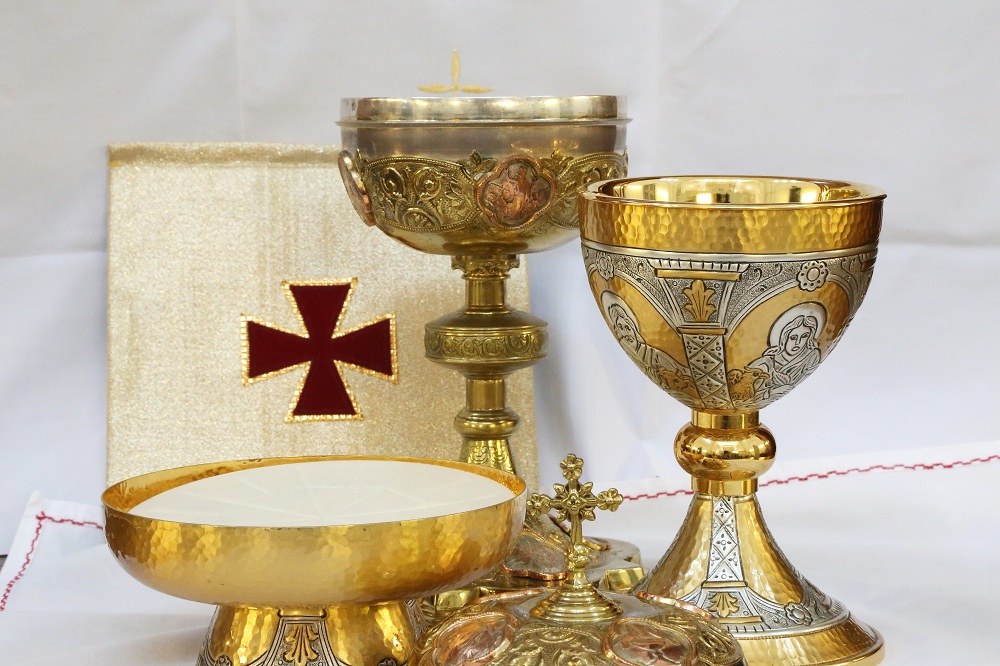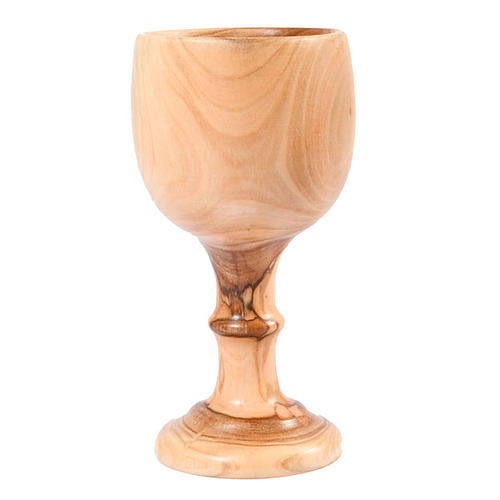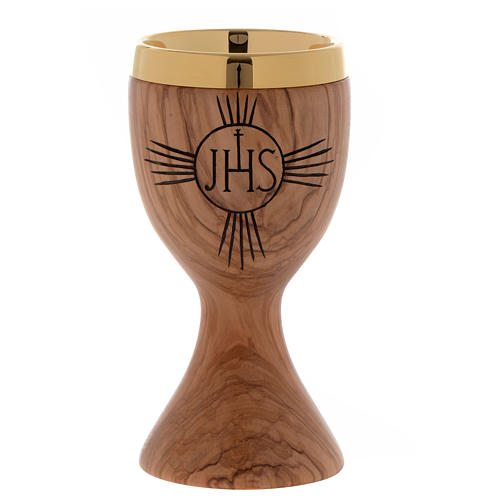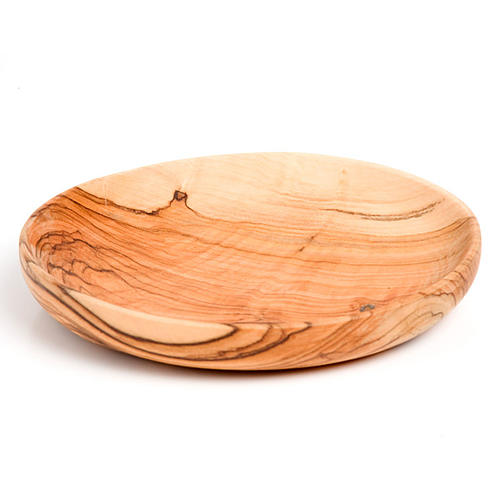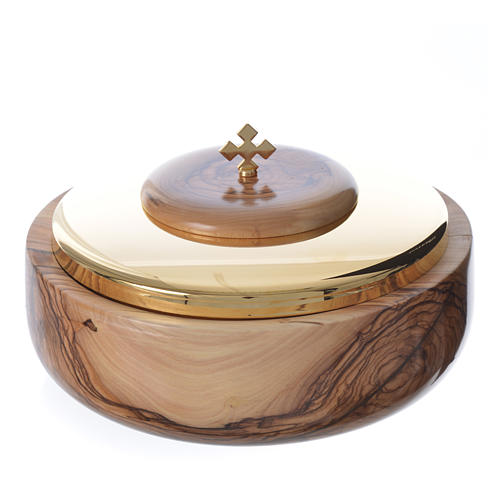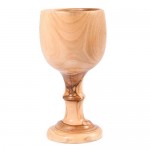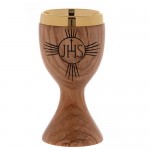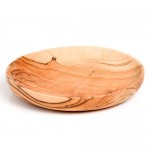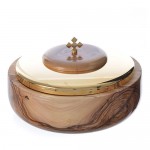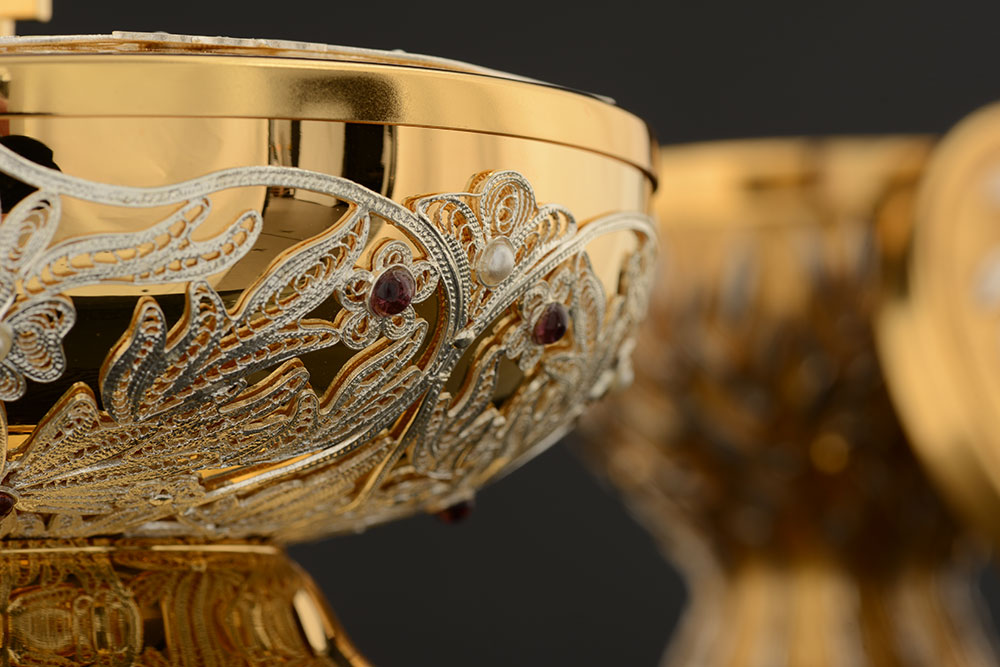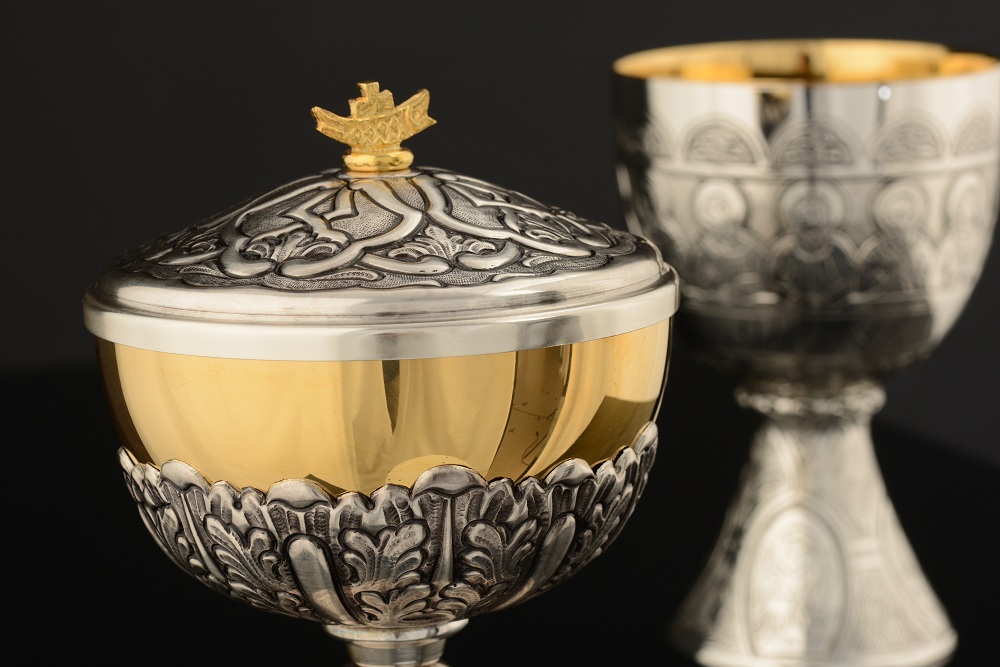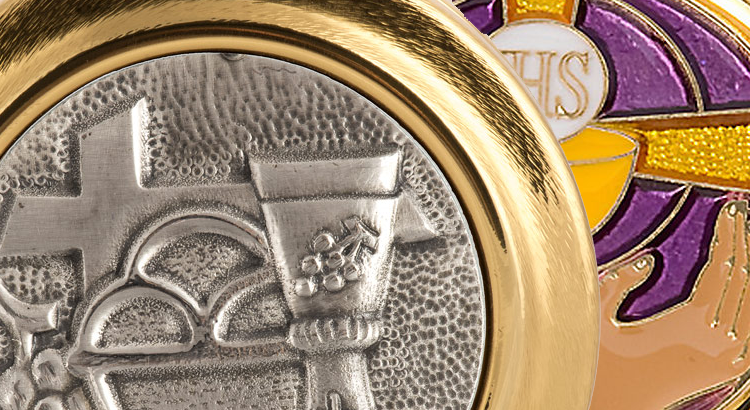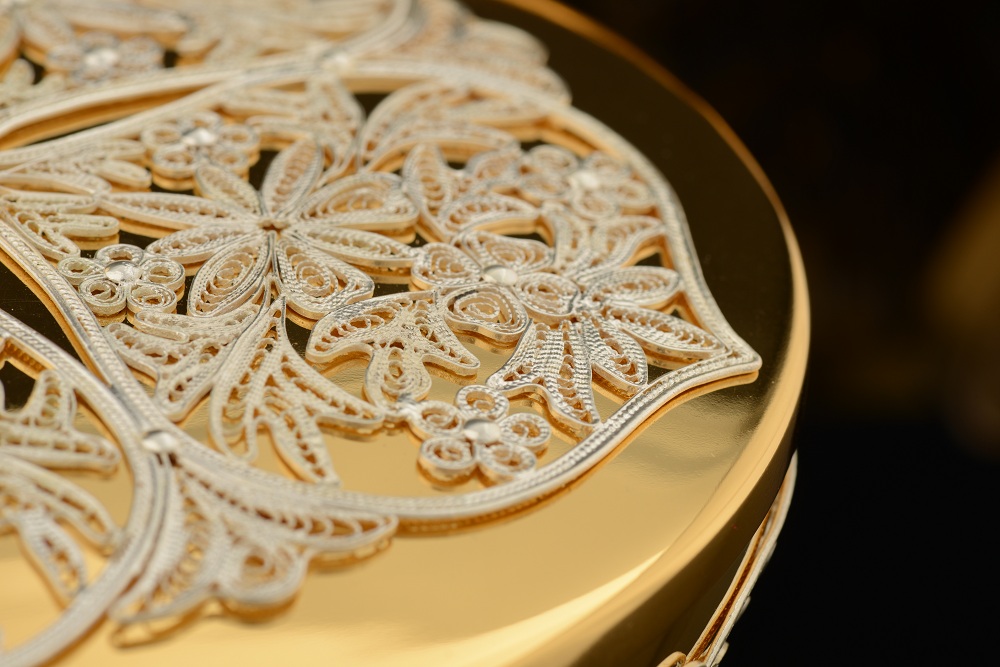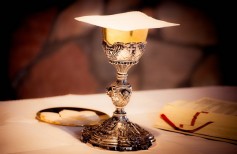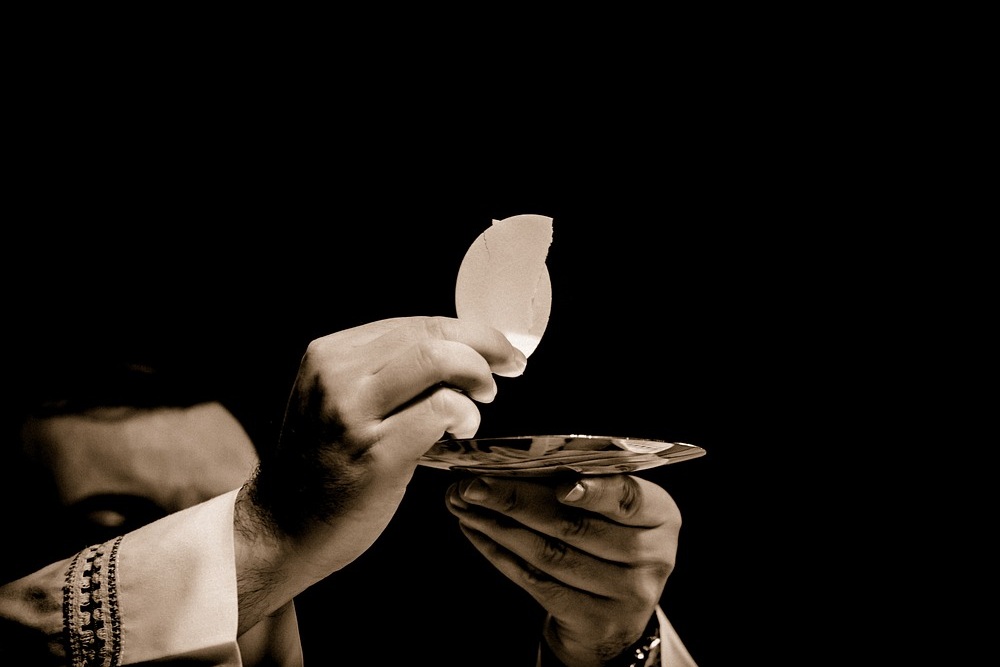Chalices, pyxes and patens. In short: sacred objects.
They have always been fundamental elements of Liturgy, and have evolved throughout centuries but never essentially changed their primary concept: storing Christ’s body and blood in a worthy way.
There are specific rules that define the use of sacred objects. Most of all, there are rules that define the material they must be made of. It seems trivial at first sight. After all, we have no idea what material the cup Jesus offered his own blood during the last supper was made of. It was probably a simple wooden or terracotta mug, but since the very first ceremonies carried out by Christian ministers at the beginning of liturgy, and even during the terrible persecutions that forced Christians to hide for centuries, it was established that the vessels that were meant to contain liturgical elements should be made of precious materials.
The reason behind this choice had needed no explanations: given the importance of their content, its inestimable and sacred value, it was obvious that the container needed to be good enough. Any Christian would consider putting Our Lord’s body and blood in an unworthy cup as debasing. Since when the cult was secret and consumed in basements and catacombs to escape from persecutions, it is a proven fact that they used precious vessels, much above the possibilities of those faithful gathering around them. Only the best was worthy of Jesus.
However, there was a bit of confusion on what materials should be right or not for the purpose for a long time. This matter was at the center of debates and controversies, to which the Congregation for the Divine Cult and the Discipline of Sacraments tried to put an end through the instruction “Redemptionis sacramentum”. What is that? It is an official document, which defines what necessarily needs to be done and what needs to be avoided concerning the Most Holy Eucharist. In chapter V, “Certain Other Matters concerning the Eucharist”, besides specifying the right place for the celebration of a Holy Mass (par. 108-109), various circumstances concerning the holy Mass (par. 110-116) and liturgical vestures (par. 121-128), the instructions lingers on sacred vessels (par. 117-120). About them, it is written that they must be blessed by the Priest according to the rituals described in liturgical books before they are used, and that the Priest, after distributing the Communion, must go back to the altar and perform the purification of paten or pyx above the chalice, which will be later dried with the purificator. Such operation can happen even after the assembly of the faithful has left the Church.
At paragraph 117, the ‘Redemptionis sacramentum’ lingers on the materials sacred objects should be made of. Here are the exact words:
[117.] Sacred vessels for containing the Body and Blood of the Lord must be made in strict conformity with the norms of tradition and of the liturgical books. The Bishops’ Conferences have the faculty to decide whether it is appropriate, once their decisions have been given the recognition by the Apostolic See, for sacred vessels to be made of other solid materials as well. It is strictly required, however, that such materials be truly noble in the common estimation within a given region, so that honor will be given to the Lord by their use, and all risk of diminishing the doctrine of the Real Presence of Christ in the Eucharistic species in the eyes of the faithful will be avoided. Reprobated, therefore, is any practice of using for the celebration of Mass common vessels, or others lacking in quality, or devoid of all artistic merit or which are mere containers, as also other vessels made from glass, earthenware, clay, or other materials that break easily. This norm is to be applied even as regards metals and other materials that easily rust or deteriorate.
Such specific indications forbid the use of sacred vessels in glass or ceramic, materials that can look beautiful and well handcrafted, but are also too fragile to contain something so precious. The use of ‘noble’ materials, that is, precious metals, is instead encouraged.
The Roman Missal General Instruction further specifies in chapter III that the sacred vessels must be made, if possible, of noble metal or, if the metal is less noble than gold or is subject to rust, they must be gilded at least on the inside (par. 328)
According to the judgement of the Episcopal Conference, in some cases also sacred vessels made of other solid and noble materials such as ebony or other hard woods can be used, provided that they do not break or deteriorate easily (par. 329); if they are meant to contain Christ’s blood, they must me made of a nonabsorbent material (par. 330).
Holyart catalog offers a wide variety of sacred objects, suitable for any ceremony and occasion, in different price ranges. In our online store, you will find metal chalices, pyxes and patens of different shapes and sizes for liturgical celebrations. Some are in silver-plated or gilded metal, more elegant and precious, decorated with the filigree technique. There is also a wide choice of steel chalices, pyxes and patens, silver, and even bronze and brass.
You can find traditional models from Molina as well as modern and contemporary ones from Forma Fluens. You can also find accessories for Holyart metal chalices, pyxes and patens, such as the chalice holder or pyx holder chest, a rotatable Plexiglas lid for pyxes and a red chalice holder bag.
About chalices, as we mentioned, you can find them of any kind, classical and modern. For example, the Molina Chalice in gilded brass with silver-plated medals depicting Jesus, Saint Joseph and Mary.
Even the pyx, the liturgical object meant to store consecrated hosts after the Eucharist celebration, has many different design options in Holyart catalog: from the classical and traditional lines of the golden pyx with striped knot, made of gilded smooth brass with silver-plated knot, to the Ciborium design metal pyx, result of strict studies on shapes and proportions, with a double finishing: a shiny finishing on the cup and a satinized finishing on the base. It also has a solid silver knob and a titanium disc.
Alternatively, more, the sumptuous Molina St. Remy pyx with silver 925 cup, handmade, recalling the style of the XII century chalice stored in the Cathedral of Reims (France). The external cup and base are hand-chiseled and show pictures of arches. Thirty-two natural mounted stones (amethyst, lapis lazuli, aventurine and garnet) ornate the pyx, which is decorated with cloisonné-fired enamel. The St. Remy pyx exquisitely combines beauty, quality and dignity in its design. Each part is handmade according to the purest techniques passed on by medieval jewelers and combined with the most modern gilding systems, in order to guarantee that each piece pay tribute to the original work and become a work of art that will raise its value with time.
The paten
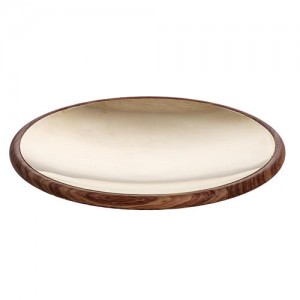
The paten is the plate or bowl used to cover the chalice and to store the host, before and after its consecration. Holyart offers many models; many of them are available with coordinated chalice and pyx. Let’s see for example the silver-plated and rosewood paten, Essentia model, simple and essential, but very elegant. Rosewood is worked in a particular way, since it is very hard to find pieces that are big enough to allow the creation of a paten with only one piece. They are cut into wedges and then worked together. The particular working of this paten makes every piece unique. Behind this decor as well, there is the study and work of architects and designers, constantly looking for a noble simplicity and sumptuousness at the same time. On a whole different level, we have the Materia paten from ‘Forma Fluens’ line, in two-tone metal, with solid but soft lines; or else, the Molina Gothic offertory paten in solid silver 925, with its elegant bas-relief depicting the four Evangelists on the knot, Christ and his twelve apostles on the cup, and Passion flower motif engraved on its base. This last paten is often sold with its matching chalice, made on special request by the Vatican as a tribute to His Holiness John Paul II for the commemoration of the fiftieth anniversary of his priesthood.
Chalices, pyxes and patens in olive wood
Holyart offers also a wide choice of sacred objects in olive wood from the Holy Land, very beautiful and simple. Olive wood has special properties that make every piece special. In fact, the wood veining are always different, as its color, which can range from ‘blond’ to ‘reddish’. The shape itself of sacred vessels in olive wood can undergo small variations according to the characteristics if the wood that is being worked. That makes each piece, even if it is made in many copies, unique.
Holyart catalog includes the very basic chalice in olive wood from the Holy Land, handmade by artisans in Bethlehem, but it is not suitable for liturgical use as it lacks an internal gilding. Alternatively, the more refined Chalice in aged olive wood from Assisi with IHS writing, entirely handmade by artisans from Umbria; the wonderful veining of aged olive wood and the quality of metals used for the cup gilding make it a real masterpiece.
About patens, here is the paten in olive wood from Jerusalem, handmade by artisans in Bethlehem (Holy Land), very simple and nice, available also with the inside in gilded brass.
About pyxes, Holyart offers for example the beautiful short pyx in olive from Bethlehem, made by Palestinian artisans from Jerusalem with local wood. The veining of the pyx can differ from one piece to another since each piece is unique, and they even change according to the features of the wood that is being worked.

